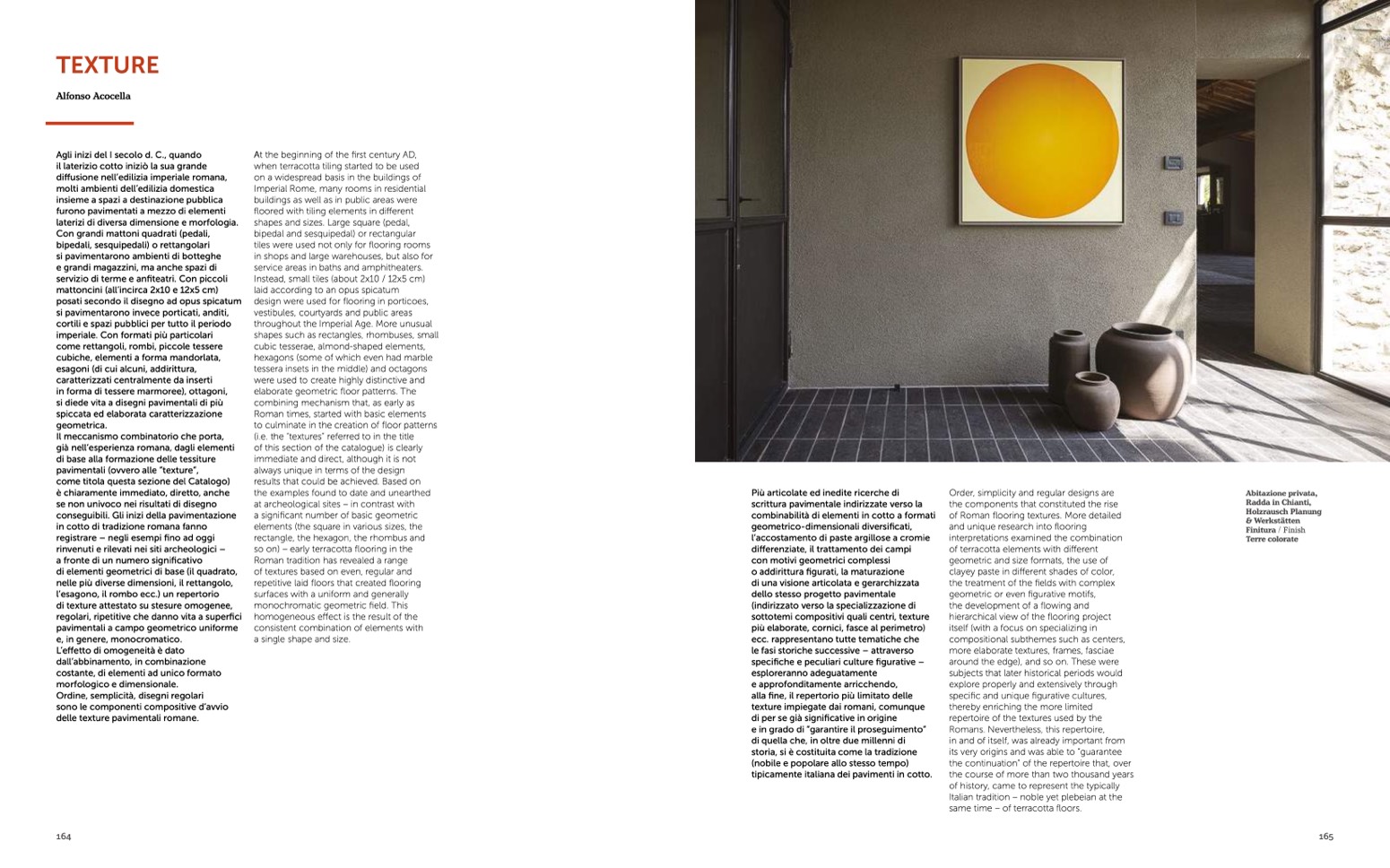
TEXTURE
Alfonso Acocella
Agli inizi del I secolo d. C., quando
il laterizio cotto iniziò la sua grande
diffusione nell’edilizia imperiale romana,
molti ambienti dell’edilizia domestica
insieme a spazi a destinazione pubblica
furono pavimentati a mezzo di elementi
laterizi di diversa dimensione e morfologia.
Con grandi mattoni quadrati (pedali,
bipedali, sesquipedali) o rettangolari
si pavimentarono ambienti di botteghe
e grandi magazzini, ma anche spazi di
servizio di terme e anfiteatri. Con piccoli
mattoncini (all’incirca 2x10 e 12x5 cm)
posati secondo il disegno ad opus spicatum
si pavimentarono invece porticati, anditi,
cortili e spazi pubblici per tutto il periodo
imperiale. Con formati più particolari
come rettangoli, rombi, piccole tessere
cubiche, elementi a forma mandorlata,
esagoni (di cui alcuni, addirittura,
caratterizzati centralmente da inserti
in forma di tessere marmoree), ottagoni,
si diede vita a disegni pavimentali di pi
ù
spiccata ed elaborata caratterizzazione
geometrica.
Il meccanismo combinatorio che porta,
già nell’esperienza romana, dagli elementi
di base alla formazione delle tessiture
pavimentali (ovvero alle ”texture”,
come titola questa sezione del Catalogo)
è chiaramente immediato, diretto, anche
se non univoco nei risultati di disegno
conseguibili. Gli inizi della pavimentazione
in cotto di tradizione romana fanno
registrare – negli esempi fino ad oggi
rinvenuti e rilevati nei siti archeologici –
a fronte di un numero significativo
di elementi geometrici di base (il quadrato,
nelle più diverse dimensioni, il rettangolo,
l’esagono, il rombo ecc.) un repertorio
di texture attestato su stesure omogenee,
regolari, ripetitive che danno vita a superfici
pavimentali a campo geometrico uniforme
e, in genere, monocromatico.
L’effetto di omogeneità è dato
dall’abbinamento, in combinazione
costante, di elementi ad unico formato
morfologico e dimensionale.
Ordine, semplicità, disegni regolari
sono le componenti compositive d’avvio
delle texture pavimentali romane.
At the beginning of the first century AD,
when terracotta tiling started to be used
on a widespread basis in the buildings of
Imperial Rome, many rooms in residential
buildings as well as in public areas were
floored with tiling elements in different
shapes and sizes. Large square (pedal,
bipedal and sesquipedal) or rectangular
tiles were used not only for flooring rooms
in shops and large warehouses, but also for
service areas in baths and amphitheaters.
Instead, small tiles (about 2x10 / 12x5 cm)
laid according to an opus spicatum
design were used for flooring in porticoes,
vestibules, courtyards and public areas
throughout the Imperial Age. More unusual
shapes such as rectangles, rhombuses, small
cubic tesserae, almond-shaped elements,
hexagons (some of which even had marble
tessera insets in the middle) and octagons
were used to create highly distinctive and
elaborate geometric floor patterns. The
combining mechanism that, as early as
Roman times, started with basic elements
to culminate in the creation of floor patterns
(i.e. the “textures” referred to in the title
of this section of the catalogue) is clearly
immediate and direct, although it is not
always unique in terms of the design
results that could be achieved. Based on
the examples found to date and unearthed
at archeological sites – in contrast with
a significant number of basic geometric
elements (the square in various sizes, the
rectangle, the hexagon, the rhombus and
so on) – early terracotta flooring in the
Roman tradition has revealed a range
of textures based on even, regular and
repetitive laid floors that created flooring
surfaces with a uniform and generally
monochromatic geometric field. This
homogeneous effect is the result of the
consistent combination of elements with
a single shape and size.
Più articolate ed inedite ricerche di
scrittura pavimentale indirizzate verso la
combinabilità di elementi in cotto a formati
geometrico-dimensionali diversificati,
l’accostamento di paste argillose a cromie
differenziate, il trattamento dei campi
con motivi geometrici complessi
o addirittura figurati, la maturazione
di una visione articolata e gerarchizzata
dello stesso progetto pavimentale
(indirizzato verso la specializzazione di
sottotemi compositivi quali centri, texture
più elaborate, cornici, fasce al perimetro)
ecc. rappresentano tutte tematiche che
le fasi storiche successive – attraverso
specifiche e peculiari culture figurative –
esploreranno adeguatamente
e approfonditamente arricchendo,
alla fine, il repertorio più limitato delle
texture impiegate dai romani, comunque
di per se già significative in origine
e in grado di ”garantire il proseguimento”
di quella che, in oltre due millenni di
storia, si è costituita come la tradizione
(nobile e popolare allo stesso tempo)
tipicamente italiana dei pavimenti in cotto.
Order, simplicity and regular designs are
the components that constituted the rise
of Roman flooring textures. More detailed
and unique research into flooring
interpretations examined the combination
of terracotta elements with different
geometric and size formats, the use of
clayey paste in different shades of color,
the treatment of the fields with complex
geometric or even figurative motifs,
the development of a flowing and
hierarchical view of the flooring project
itself (with a focus on specializing in
compositional subthemes such as centers,
more elaborate textures, frames, fasciae
around the edge), and so on. These were
subjects that later historical periods would
explore properly and extensively through
specific and unique figurative cultures,
thereby enriching the more limited
repertoire of the textures used by the
Romans. Nevertheless, this repertoire,
in and of itself, was already important from
its very origins and was able to “guarantee
the continuation” of the repertoire that, over
the course of more than two thousand years
of history, came to represent the typically
Italian tradition – noble yet plebeian at the
same time – of terracotta floors.
Abitazione privata,
Radda in Chianti,
Holzrausch Planung
& Werkstätten
Finitura / Finish
Terre colorate
164
165

